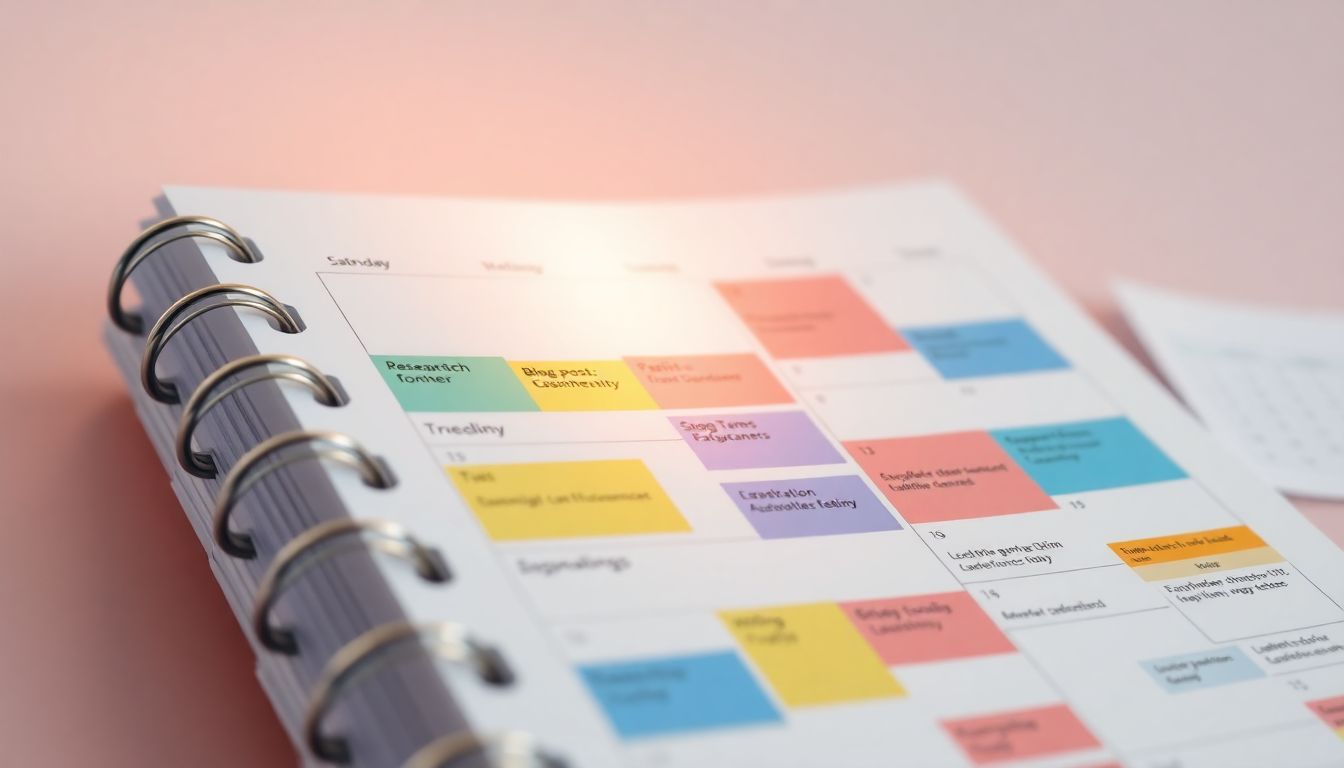
How to Create a Blogging Schedule That Actually Works
Ever feel like your blog is a runaway train? One week you're posting daily, the next, crickets! It's tough to keep up.
Without a plan, blog posts become scattered. Your audience loses interest. You miss chances to connect, and time goes to waste. Isn't there a better way?
Yes! A blogging schedule brings order to the chaos. It boosts consistency, elevates content, and strengthens your SEO. Let's dive into making one that works.
Why You Need a Blogging Schedule
A blogging schedule isn't just a calendar. It's a road map to blog success. It guides your content and keeps you on track.
The Impact of Consistency on Blog Growth
Regular posting builds trust. It shows you're serious. Readers know when to expect new content. This keeps them coming back. Did you know consistent blogging can boost website traffic by up to 6x?
Actionable Tip: Set small, achievable posting goals. Don't overcommit! Stick to the plan. Even one post per week is a great start.
Improved Content Quality Through Planning
Rushed content is never good. Scheduling allows for better research. You have time to write, edit, and polish each post. This results in higher-quality articles.
Imagine you're baking a cake. You wouldn't throw ingredients together at the last minute. You'd follow a recipe. You'd plan each step. Blogging is the same!
SEO Benefits of a Regular Posting Cadence
Search engines love fresh content. They favor regularly updated sites. A consistent schedule signals to Google that your site is active. Plan posts around keywords to boost search rankings.
Actionable Tip: Use a content calendar to plan posts. It will keep you on track.
Step-by-Step Guide to Building Your Blogging Schedule
Ready to build your blogging schedule? It's easier than you think. Here's how to get started.
Step 1: Defining Your Blogging Goals and Audience
What do you want to achieve with your blog? Who are you writing for? Align your content with those interests and aims.
Researching your audience is key. Know what they like. Learn their needs. This ensures your content resonates.
Actionable Tip: Use surveys to gather info. Look at comments on your social media.
Step 2: Brainstorming Content Ideas
Time to brainstorm some ideas! Think about topics your audience cares about. What problems can you solve? What questions can you answer?
Try different brainstorming methods. Mind maps, keyword research, and competitor analysis are all great. Create a master list of potential topics.
Actionable Tip: Use keyword research tools. They can help.
Step 3: Creating a Content Calendar
A content calendar keeps your blog organized. Use a spreadsheet or a dedicated tool. Include key info for each post. Add the publish date, title, and target keyword. Add the author and status.
Keep the calendar accessible. Make sure your whole team can use it.
Actionable Tip: Color-code your calendar. It helps to easily visualize progress.
Choosing the Right Blogging Frequency
How often should you post? There's no magic number. The ideal frequency depends on your audience. It also depends on your industry, and your resources.
Balancing Quantity and Quality
Quality trumps quantity. Always. It's better to post less often with amazing content. Don't sacrifice quality for frequency.
Actionable Tip: Review old posts. Can you improve them? Freshen up the content.
Analyzing Your Competition's Posting Schedule
What are your competitors doing? Research their content and posting habits. This provides insights into what works in your niche.
Don't copy them! But learn from them. Identify gaps you can fill.
Actionable Tip: Use competitor analysis tools to check.
Maintaining and Adapting Your Blogging Schedule
A schedule isn't set in stone. It needs to evolve. Stay flexible and make changes when needed.
Tracking Your Progress and Performance
Use analytics to monitor your blog posts. See which ones perform best. What topics resonate with your audience?
Track key metrics like page views, bounce rate, and social shares. This informs your content strategy.
Actionable Tip: Use Google Analytics or similar tools.
Dealing With Writer's Block and Unexpected Delays
Writer's block happens. It's a common problem. So are unexpected interruptions. Keep a list of backup topics ready.
Batch writing can help too. Write several posts in advance. This prepares you for busy periods.
Actionable Tip: Take breaks. Step away from your computer.
Conclusion
Creating a blogging schedule doesn't need to be scary. Define your goals. Brainstorm ideas. Use a content calendar. You can maintain consistency. It allows you to improve quality, and boost SEO.
Start today! Pick one or two tips and begin. The long-term benefits are worth the effort. Your blog will thank you.